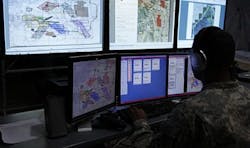EDITOR'S NOTE: The dollar value of this contract was updated by the Pentagon on 1 Aug. 2013 to $79 million. Officials of the public affairs office of the U.S. Office of the Secretary of Defense originally stated the amount of the contract incorrectly as $29 million when the deal was announced on 30 July. The precise amount of the contract, announced on 1 Aug. in a publically released correction, is $79,051,718.
ARLINGTON, Va., 1 Aug. 2013.Military intelligence sensor processing experts at the BAE Systems Electronic Solutions segment in Burlington, Mass., are beginning an advanced project to design a next-generation intelligence, surveillance, and reconnaissance (ISR) exploitation and resource management system that fills gaps in today’s military intelligence analysis capability.
Intelligence analysts at the U.S. Defense Advanced Research Projects Agency (DARPA) in Arlington, Va., announced a $79 million contract to BAE Systems on Tuesday for the second phase of the Insight program to refine and mature technologies developed in the program's first phase.
U.S. intelligence-analysis systems today link intelligence sources to tactical operations centers manually by chat-based operator interaction, which can limit the ability to deal with fast-moving and rapidly changing threats.
The Insight program of the DARPA Information Innovation Office seeks to rectify this situation by integrating human and machine reasoning into intelligence equipment to blend operator knowledge and reasoning into intelligence-processing computers when dealing quickly with complex data from different sensors.
While the program's first phase created the baseline system with an initial focus on counter-insurgency operations, the second phase not only will mature phase-one capabilities, but also will add additional capabilities for expanded missions.
In phase two BAE Systems will analyze and use information from imagers and other kinds of battlefield sensors to help warfighters detect and identify threats by using behavioral discovery and prediction algorithms.
This phase also will detect and identify enemy networks by integrating information from all possible sources, including military intelligence repositories, human reporting, and space, air, sea, and ground-based sensors.
Among the program's goals are replacing existing stovepipes with an integrated ISR system; provide tools and automation to increase analyst productivity; promote efficient collaboration among analysts; and enhance the efficiency and effectiveness of individual analysts through a unified global ISR picture.
DARPA scientists are asking BAE Systems for an open, standards-based, multi-source, plug-and-play architecture to enable rapid integration of existing and emerging ISR technologies and make it easy to add, remove, substitute, and modify hardware and software components.
BAE Systems and Science Applications International Corp. (SAIC) in McLean, Va., won DARPA Insight phase-one contracts in spring 2011, and wrapped up their work last winter. The companies started designing a next-generation ISR exploitation and resource management system that may help U.S. intelligence experts detect threat networks, irregular warfare, and terrorist operations.
The companies developed technologies that combine intelligence information from imaging sensors, crowd-source and other social network or text-based sensors, and other sources for further analysis, and cross-cue different intelligence sources automatically.
BAE Systems and SAIC have built model-based behavioral correlation, modeling, prediction, and threat network analysis tools that combine intelligence information across many different sources automatically to improve the efficiencies of multi-intelligence sensors.
In the second phase of the DARPA Insight program, BAE Systems will continue making progress in developing a unified data-management and processing environment that integrates new intelligence sensors and software algorithms.
On the contract announced this week, BAE Systems will do the work in Burlington, Mass.; McLean, Va.; Woburn, Mass.; Cambridge, Mass.; Boulder, Colo.; Alexandria, Va.; Cherry Hill, N.J.; Toronto; Medford, N.J.; and Vienna, Va., and should be finished by early 2016.
For more information contact BAE Systems Electronic Systems online at www.baesystems.com, or DARPA at www.darpa.mil.



